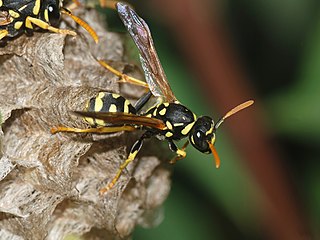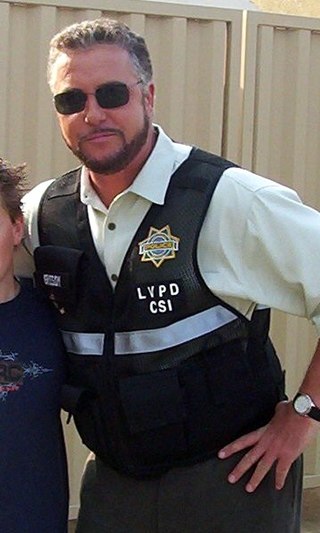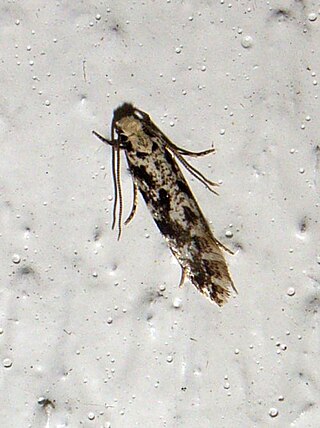
Polistes is a cosmopolitan genus of paper wasps and the only genus in the tribe Polistini. Vernacular names for the genus include umbrella wasps, coined by Walter Ebeling in 1975 to distinguish it from other types of paper wasp, in reference to the form of their nests, and umbrella paper wasps. Polistes is the single largest genus within the family Vespidae, with over 200 recognized species. Their innate preferences for nest-building sites leads them to commonly build nests on human habitation, where they can be very unwelcome; although generally not aggressive, they can be provoked into defending their nests. All species are predatory, and they may consume large numbers of caterpillars, in which respect they are generally considered beneficial.

William Louis Petersen is an American actor. He is best known for his role as Gil Grissom in the CBS drama thriller series CSI: Crime Scene Investigation (2000–2015), for which he won a Screen Actors Guild Award and was nominated for a Golden Globe Award; he was further nominated for three Primetime Emmy Awards as a producer of the show. He reprised his role as Gil Grissom in the sequel CSI: Vegas, which premiered on October 6, 2021.

The Plasmodiidae are a family of apicomplexan parasites, including the type genus Plasmodium, which is responsible for malaria. This family was erected in 1903 by Mesnil and is one of the four families in the order Haemospororida.

Charopidae is a taxonomic family of small air-breathing land snails, terrestrial pulmonate gastropod mollusks in the superfamily Punctoidea.

Infurcitinea is a genus of the fungus moth family, Tineidae. Therein, it belongs to the Meessiinae, one of the larger fungus moth subfamilies.

Nemapogon is a genus of the fungus moth family, Tineidae. Therein, it belongs to the subfamily Nemapogoninae. As evident by its name, it is the type genus of its subfamily.

Clavaria is a genus of fungi in the family Clavariaceae. Species of Clavaria produce basidiocarps that are either cylindrical to club-shaped or branched and coral-like. They are often grouped with similar-looking species from other genera, when they are collectively known as the clavarioid fungi. All Clavaria species are terrestrial and most are believed to be saprotrophic. In Europe, they are typical of old, mossy, unimproved grassland. In North America and elsewhere, they are more commonly found in woodlands.
Famelica is a genus of sea snails, marine gastropod mollusks in the family Raphitomidae.

Pleurotomella is a genus of sea snails, marine gastropod mollusks in the family Raphitomidae.

Gymnobela is a genus of sea snails, marine gastropod mollusks in the family Raphitomidae.

Setia is a genus of minute sea snails, marine gastropod mollusks or micromollusks in the family Rissoidae.

Eulima is a genus of small, ectoparasitic sea snails, marine gastropod mollusks in the family Eulimidae.
Hervé de Toulgoët was a French entomologist. He specialised in moths of the families Arctiidae and Zygaenidae. He also studied the beetle genus Carabus. He was written about by Paul Thiaucourt and Jocelyne Navatte.

Bittacus is a genus of hangingflies in the order Mecoptera. Members of the genus have a cosmopolitan distribution. The genus has existed since at least the earliest Late Cretaceous. Bittacus is considered "grossly paraphyletic" and serves as a catch-all for many distantly related species of hangingflies.
Hemiliostraca is a genus of sea snails, marine gastropod mollusks in the family Eulimidae.

Ectopleura is a genus of hydrozoans in the family Tubulariidae.

Tubulariidae is a family of hydroid cnidarians. For long placed in a presumed superfamily or infraorder Tubulariida of suborder Capitata, they are actually close relatives of the Hydridae and are now united with these and a number of relatives in a newly recognized suborder Aplanulata. Most if not all species in this family grow on stalks and resemble small flowers.

Apertochrysa is a genus of green lacewings in the family Chrysopidae. There are 183 described species in the genus.
Leptometopa is a genus of freeloader flies in the family Milichiidae. There are about 19 described species in Leptometopa.
Ectrepesthoneura is a genus of fungus gnats in the family Mycetophilidae. There are more than 20 described species in Ectrepesthoneura.















